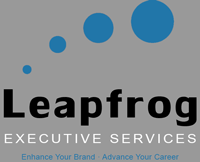In the Story of Your Brand, the Hero Isn’t You
Category : 2018
Since campaigning for class office in junior high, Leslie Nunn Reed has been a student and a story of successful branding. Today, as vice president at 5by5 – A Change Agency, Leslie helps clients tell their stories with clarity, reach, and impact, including names like Scott Hamilton, musician Matthew West, Compassion International, and Vanderbilt University Medical Center[1] .
During an engaging conversation with Leapfrog Executive Services, Leslie shared her branding insights and expertise. This is the first in a series sharing the 5by5 perspective on branding (5by5 is a StoryBrand certified Agency).
Whether for an organization or an executive, at its core, a brand is a promise you make to your customers about what you stand for, who you stand for, what you do, and how you do it. The human brain is drawn to clarity and rejects confusion. You can’t expect customers or people considering you for a C-level role to figure out who you are and the value you bring. Whether you are a global company or a successful executive, your brand needs a cohesive image and message to tell who you are and what problem you solve. Companies (and people) with a clear message win in the marketplace.
A brand is your story about your customer. When you talk about you to the customer, you’re making yourself the hero of the story. Great branding makes the client the hero and you the authoritative, trusted guide who helps the hero solve his or her problem. When meeting with an executive team, it is far more effective to show how you will solve business problems than to talk about your successes at another company.
The driving force in a strong brand is transparent trust that grows from consistency between what is said and the customer’s experience. Trust is earned and is very specific. Clients may trust a company or person in one area, but not another.
In discussing companies (or individuals) trying to create a brand perception inconsistent with who they are in practice, Leslie responded, “That disparity is confusing, and customers won’t burn the calories required to reconcile the confusion. They’ll simply move on to what is consistent and what they can understand.”
Whether someone looking for the next opportunity or a company looking for their next client, the Branding Process has three elements-
- Assessment: Use objective research and market analysis to validate the ecosystem, audience, potential and existing brand perceptions. Then, develop a brand strategy and ways to communicate the message. When multiple brands compete for the same audience, the answer is to simplify-get clear on the message.
- Brand Harmony: The brand look and sound must work together in concert. The photography, typeface, and colors must align and communicate the same message before creative visuals can be developed. Your LinkedIn photo should be professional-not an action shot on the golf course.
- Driving the Brand: Multiple avenues are used to drive a brand – website design, content marketing, sales strategy, digital advertising and social media, influencer strategies, and the internal team. Again, all work together in concert in a successful brand strategy. On a personal level, a personal website, a strong LinkedIn profile, and professional comments on Twitter and LinkedIn all contribute to driving an executive’s brand.
When communicating consisted of sending radio waves into the air, engineers monitored and measured signal strength and clarity on a 5-point scale. When a message arrived loud and clear, both dimensions were rated a perfect five – giving the 5by5 Agency its name. Technology has transformed how we communicate and the speed with which it happens. But effective messaging in any environment demands strength and clarity. The individual or company with a solid brand will always aim for 5by5.
Learn more about …

